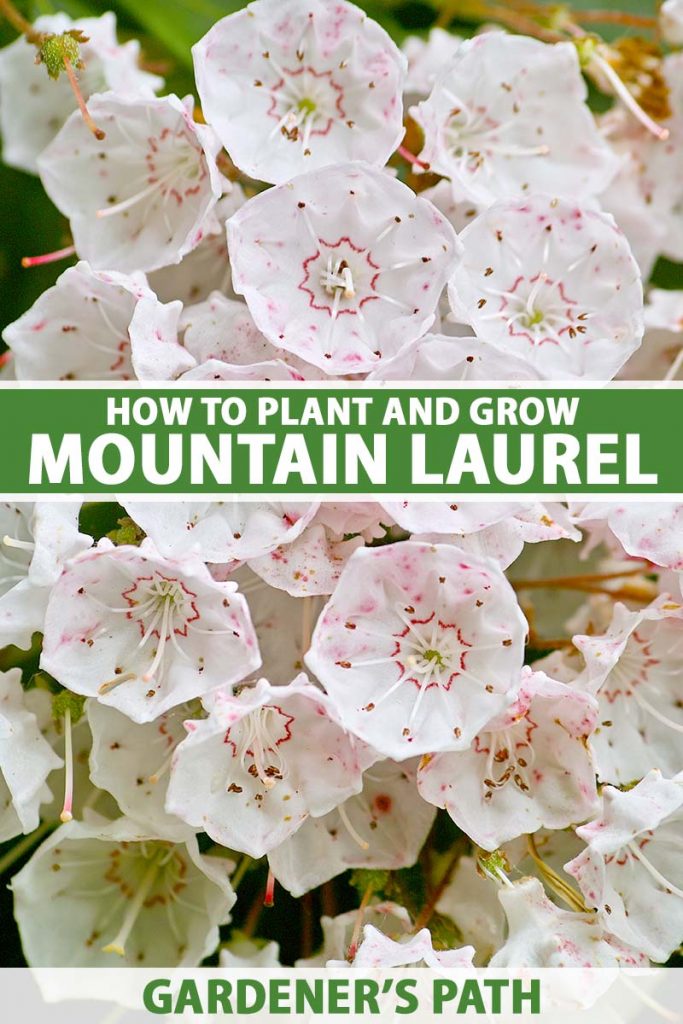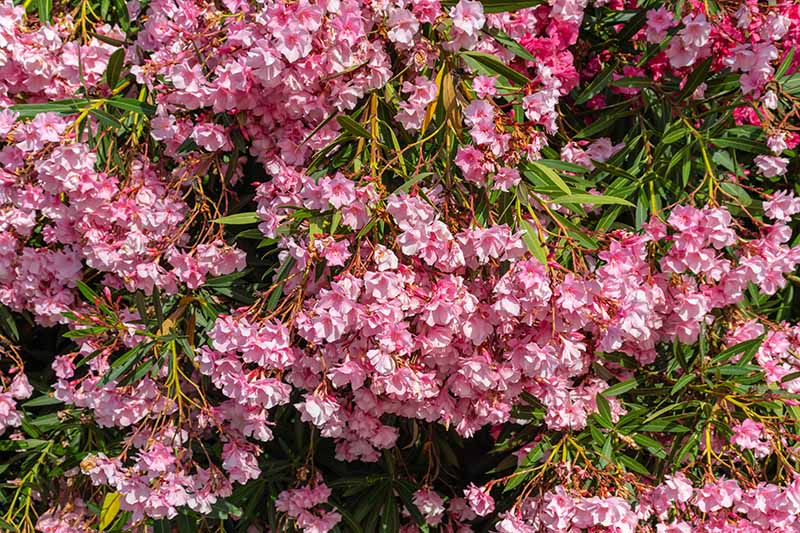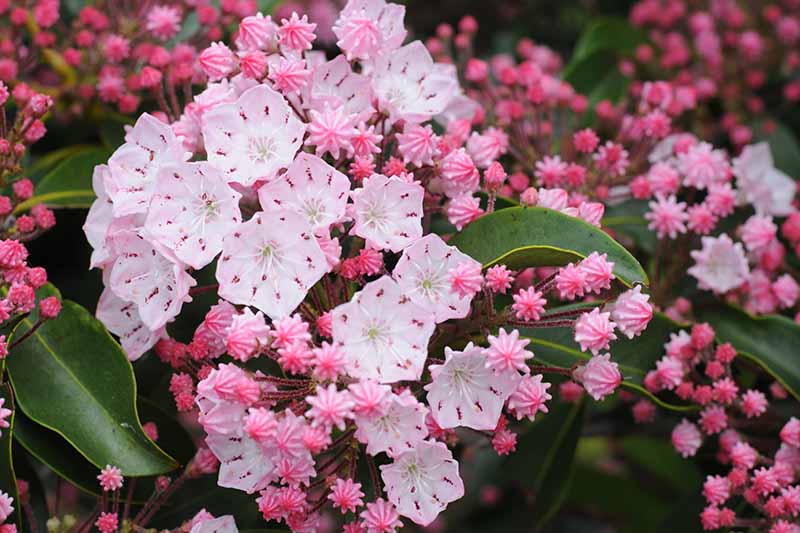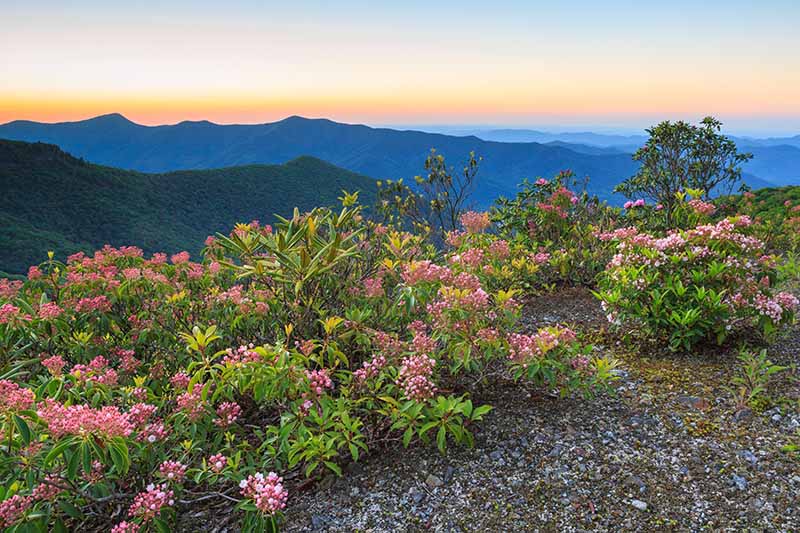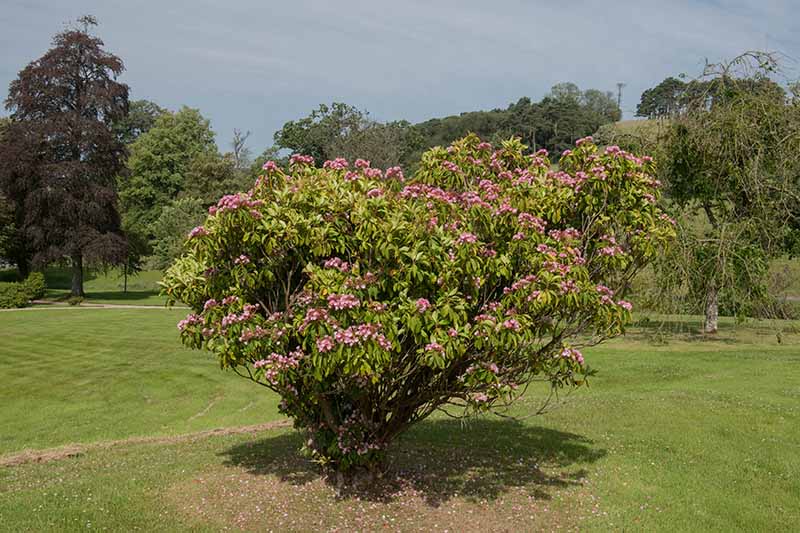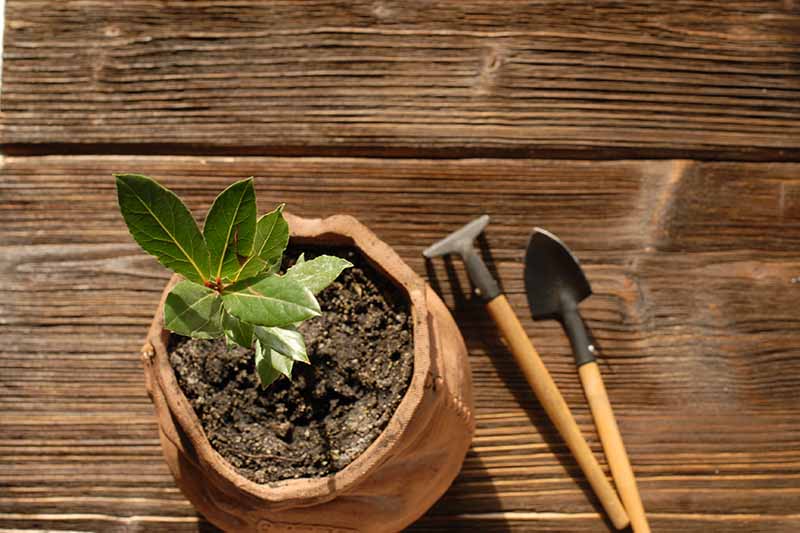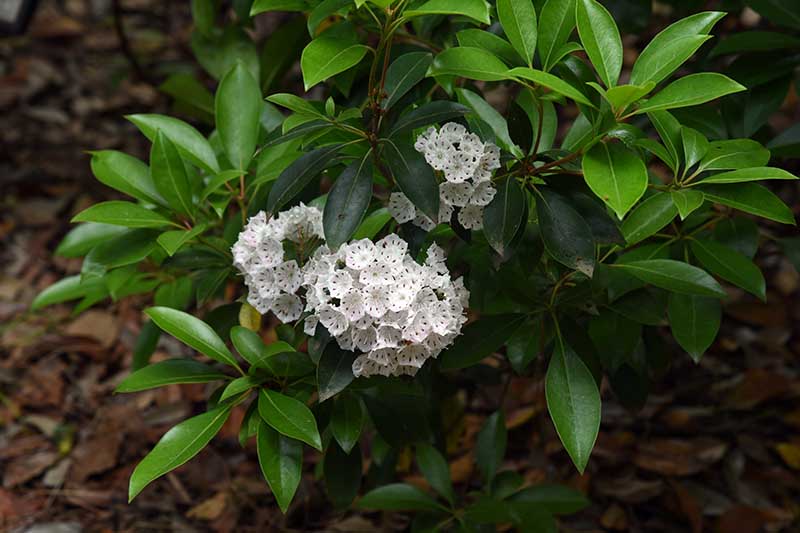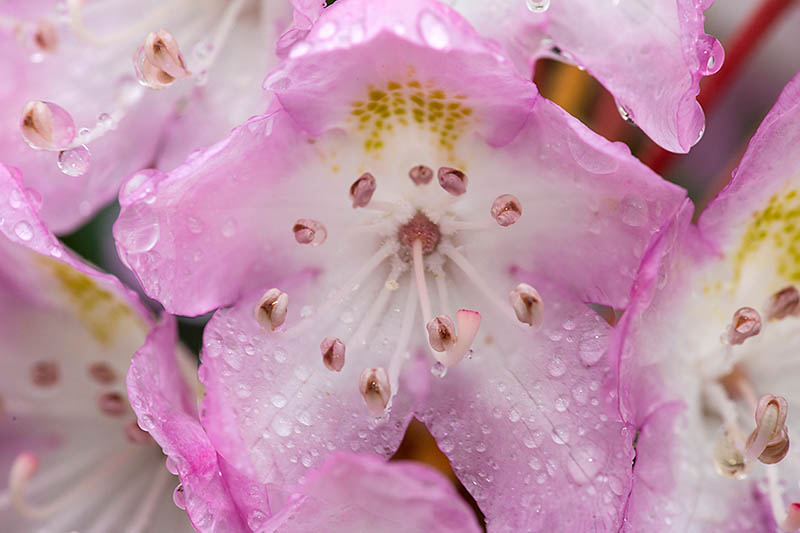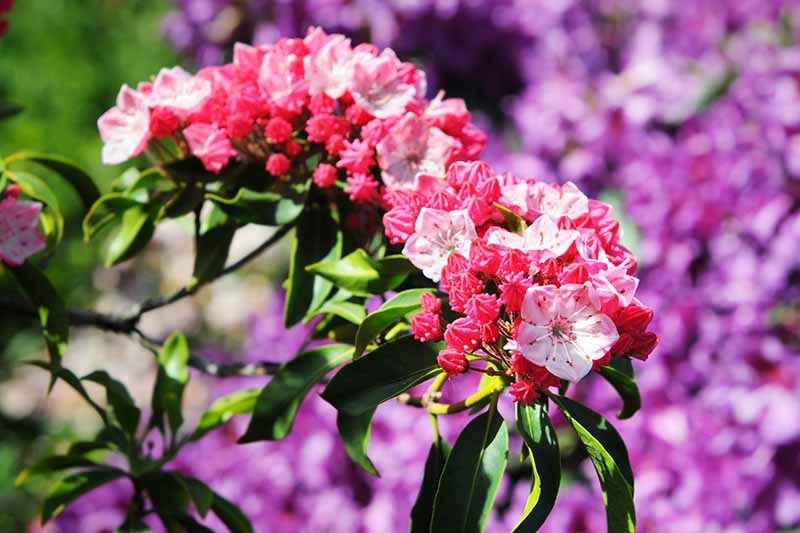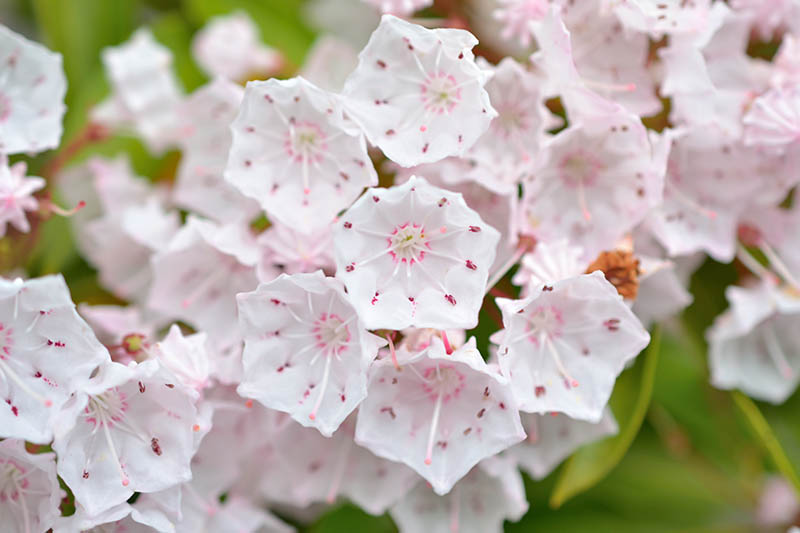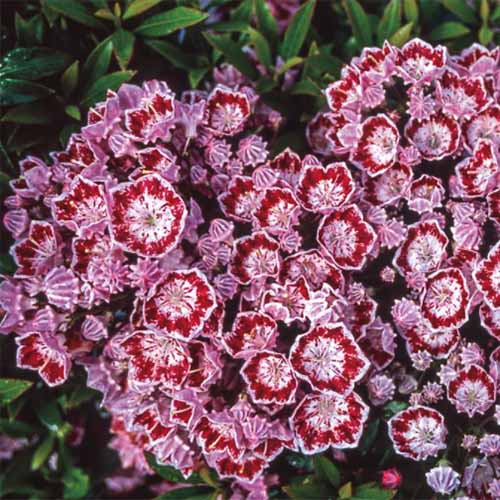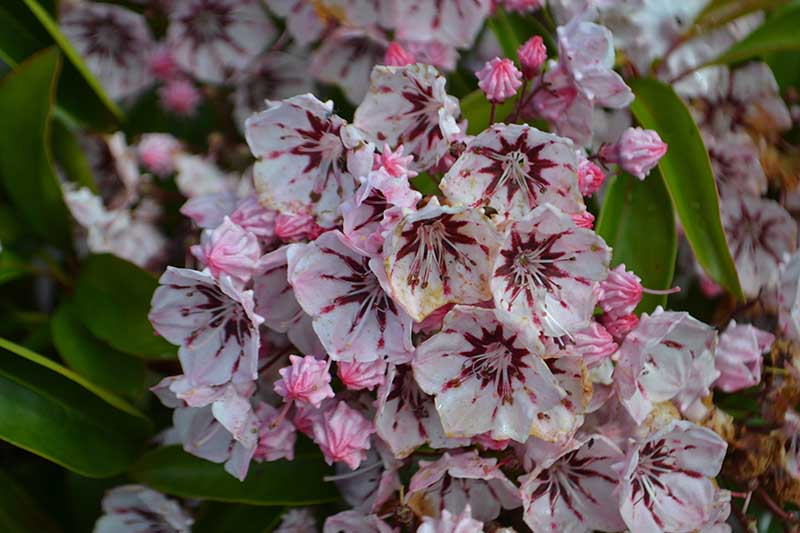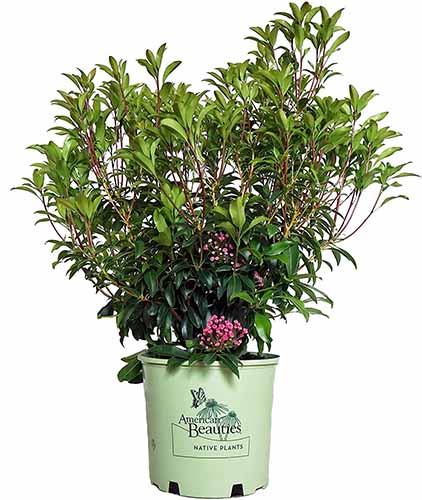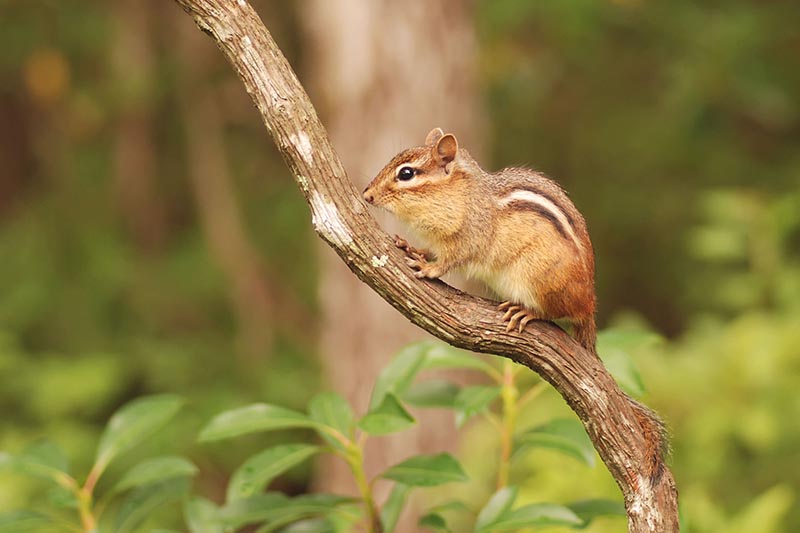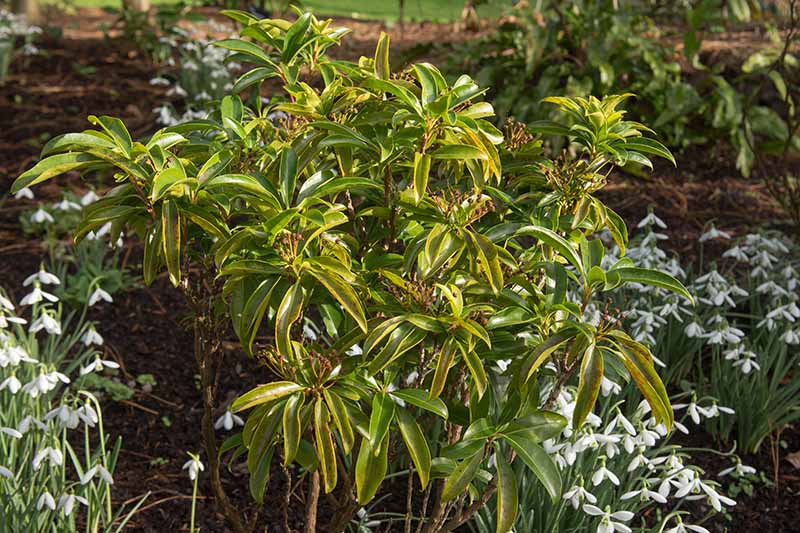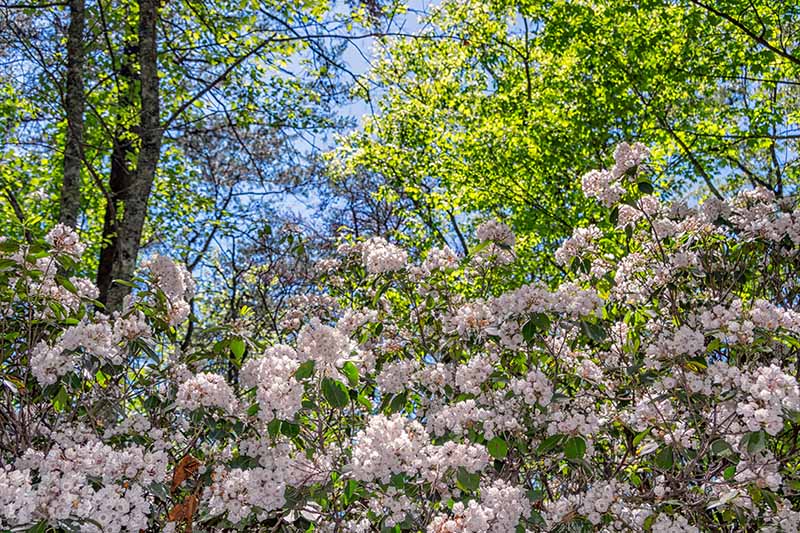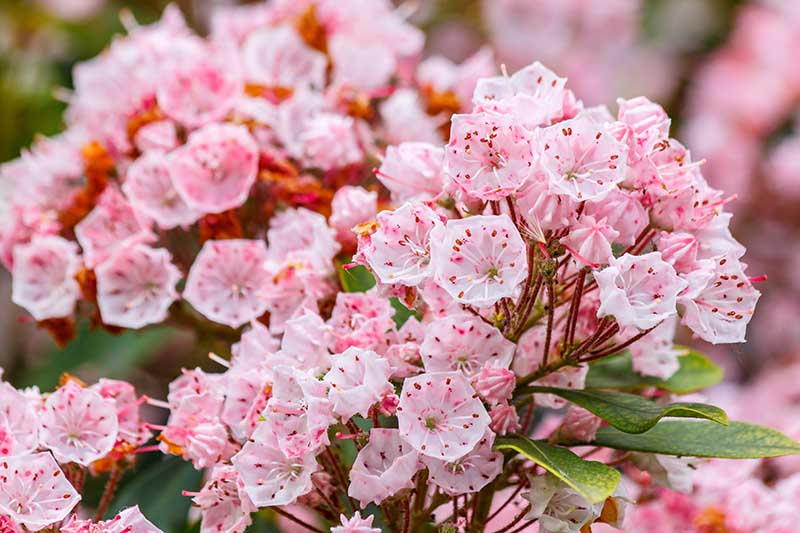It has been several years since I moved from western North Carolina up to Vermont, but when spring comes around I still pine for mountain laurel blooming season in the Smokies. Fortunately for me, it is possible to recreate this incredible sight in the home garden. We link to vendors to help you find relevant products. If you buy from one of our links, we may earn a commission. With beautiful evergreen foliage and spectacular springtime displays of flowers, mountain laurel can take any landscape design to the next level. It is perfect for borders, backdrops, and living hedges.
If you live in USDA Hardiness Zones 5-9, you can easily grow mountain laurel in your garden. This plant should not be confused with Texas mountain laurel, Dermatophyllum secundiflorum, a member of the pea family.
Cultivation and History
Mountain laurels are native to the eastern United States. These woody shrubs belong to the Ericaceae family, and they are related to blueberries, rhododendrons, and azaleas.
K. latifolia has been cultivated since the early 18th century, at which time it was introduced to England as an ornamental plant for flower gardens. Around 80 cultivars have since been developed, many originating in the 1960s at the Connecticut Agricultural Experiment Station by Dr. Richard A. Jayes, a horticulturalist devoted to studying mountain laurel. These beautiful shrubs are famous for their clusters of pink or white flowers with small distinct markings. They bloom in late spring.
Perhaps best known for growing wild en masse along the Blue Ridge Parkway in the southern Appalachians, this attractive shrub can be found growing in thickets on rocky mountain slopes and forest edges all along the eastern US from northern Florida all the way up to southern Maine. It is even recognized as the state flower in both Connecticut and Pennsylvania.
While mountain laurel can grow to an impressive 30 feet or more in the wild, these shrubs usually don’t exceed 10 feet in cultivation. Beware, all parts of the plant are poisonous, so take care with children and pets if you are growing this species.
Propagation
Mountain laurel can be propagated in a number of ways, including by seed and from cuttings. But the process is slow, and many people prefer to purchase this plant from a nursery.
From Seed
Mountain laurel plants have tiny seeds that are encased in pods, each containing between 300 and 700 seeds. You may sometimes be able to find seeds at a nursery, or you can easily collect them yourself. Once the flowers have faded and the seed pods developed, cut them off and dry them in a paper bag for a few weeks until they can be cut open easily to remove the seeds. These seeds germinate best if cold stratified, so store them in the refrigerator in a plastic bag wrapped in a moist paper towel for about two months to begin. Next, sprinkle several seeds in two to four-inch pots filled with peat and sprinkle a very light covering on top. Seeds require light for germination, so set the pot under grow lights or somewhere with available natural light. Mist regularly and keep pots around 75°F. Seeds should germinate in around 30 days. Once seedlings emerge, thin to one seedling per pot. Continue to monitor and keep them moist. This is a slow process. Seedlings should be kept inside to continue to grow for a full growing season, until roots are well established.
From Cuttings
It is also possible to grow mountain laurel from cuttings. This may be a good option if you already have one plant growing and want to cheaply clone it to create a larger patch. Start by taking six to eight-inch cuttings from healthy current year growth. This could be in early spring, or between August and December, depending on the climate.
Remove all but the top two leaves, dip cuttings in rooting hormone powder, and then plant in four-inch pots filled with equal parts perlite, coarse builder’s sand, and peat moss. Plant just deeply enough so the cuttings will stand without support. Water until moist. You can cover the containers with tented plastic bags to retain moisture, just be sure to remove these regularly to water and mist the leaves. Cuttings should be kept warm at 75°F, moist, and out of direct sun until rooted, which can take four to six months. Rooted cuttings can be planted outside once the roots are well established. Plant out in the spring after the risk of frost has passed.
From Seedlings/Transplanting
After all danger of frost has passed, dig a hole two or three times the width of the roots, and mix an inch or two of compost into the hole. Set the shrub in the hole so the crown ends up slightly higher than ground level. Refill the hole with soil, watering once about halfway through, and again once it is completely filled in. Add a thick three or four-inch layer of pine needles or bark mulch to help to regulate the soil temperature and retain moisture, leaving a few inches bare around the crown. If planting several shrubs in one area, you can use a garden fork or tilling tool to loosen about six to 12 inches of soil and mix a few inches of compost into the entire bed. Space plants five to 10 feet apart.
How to Grow
Similar to azaleas and rhododendrons, mountain laurel requires cool, moist, well draining, acidic soil amended with compost.
It is best to avoid planting in heavy clay soil. If you tend to have issues with drainage, consider planting in raised beds to reduce the risk of rot. Soil pH should be somewhere between 4.5 and 5.5. If the pH is too high, try working some peat moss or finished compost into the top six inches of soil. Shredded leaves, pine needles, compost, and coffee grounds can all help to lower soil pH.
If you are unsure about the soil acidity, consider using a pH testing kit to test it. You can learn all about soil testing here. While mountain laurel will grow in a range of light conditions, it does best in part shade or dappled sunlight. Bright sun could scorch the leaves and full shade may inhibit flower production. Mountain laurel has shallow roots and requires frequent watering until established. During the first year of growth, newly planted shrubs should receive an inch or two of water every week.
It is also recommended to apply a thick mulch such as pine needles, shredded bark, or wood chips to help retain moisture in the soil between waterings. Avoid overhead watering as much as possible to decrease risk of disease. These shrubs are hearty and don’t typically require much extra feeding. It is best not to over fertilize this plant, as an excess of nutrients could encourage growth of foliage at the expense of blooming. Personally, I prefer to amend the garden bed with fresh compost each season. If using a commercial fertilizer, select one formulated for acid loving plants. Apply at a quarter strength, feeding only once per season in the spring.
Growing Tips
Plant in cool, moist, well draining soil with a pH of 4.5-5.5. Add a thick layer of mulch to retain moisture and regulate soil temperature. Choose a site with part shade or dappled sunlight. Provide an inch or two of water per week during the first year. Amend the garden bed with aged compost each season.
Pruning and Maintenance
While not often needed, it is helpful to prune occasionally to remove dead or damaged branches and to increase airflow.
Prune just after flowering, before new buds have a chance to form. Use sterile garden shears to remove damaged, diseased, or crossing branches. Mountain laurel can tolerate heavy pruning, just be sure never to remove more than a third of the plant at a time. Deadheading flowers once they fade will also help plants to focus energy on growth rather than seed development, and will consequently improve next year’s flower display.
Cultivars to Select
Mountain laurel is available in a wide variety of cultivars to fit any landscaping need. It can be found in a range of sizes and colors, typically featuring dramatic showy flowers and shiny evergreen foliage. You will likely be able to find young shrubs at your local nursery, but if not you can certainly find them online as well. Here are a few of my favorites:
Elf
A popular cultivar, this semi-dwarf grows just three feet tall and wide, and features pink buds opening to spectacular clusters of pale pink flowers with white overtones, and long narrow dark green foliage.
Its compact size and smaller leaves makes it an ideal option for group plantings, especially in areas with partial shade.
Minuet
This compact yet impressive cultivar grows only 36 inches tall and wide.
Managing Pests and Disease
While these are hardy shrubs with some natural chemical protections, they are still susceptible to a few pests and diseases.
‘Minuet’ Its compact size makes it a perfect choice for a low hedge or a woodland flower garden. Spring Hill Nurseries has live shrubs in 2.5-quart pots available for purchase from Home Depot.
Peppermint
Another impressive variety, this shrub is characterized by pink flower buds which open to striking pale pink flowers with dark red stripes from the center to the outer petal, giving them the unique appearance of a peppermint candy.
This full size shrub grows up to 10 feet tall.
Pink Charm
This evergreen shrub has spreading branches holding dense, deep green foliage and deep pink flowers which attract bees, butterflies, and woodland birds. ‘Pink Charm’ Mature shrubs can reach up to 10 feet tall and wide. This cultivar does well in partial to full shade and makes a great hedge shrub.
Herbivores
Since these shrubs contain glycosides, which are toxic to many animals, damage from herbivores is minimal. Rodents may feed on stem tissue during the winter, especially if mulch is pressed up against the crown.
Deer seldom cause damage, though you may find them occasionally nibbling on the leaves in the winter when other food is scarce.
Insects
Keep an eye out for signs of a few common pests. As long as you know what to look for, you should be able to keep insects under control before they can do significant damage.
Lace Bugs
These common pests (Stephanitis pyrioides and S. rhododendri) are small square bugs that suck sap from the foliage, causing leaf discoloration. Luckily, lace bugs are easy to spot and can be removed manually or by hosing the leaves off regularly with a strong stream of water. If infestations become large, spraying foliage with neem oil is an effective treatment. Find tips on controlling lace bugs here.
Rhododendron Borers
The small, pale larvae of Synanthedon rhododendri cause damage to branches by boring holes into the stems where they then overwinter. You may notice small piles of sawdust where holes have been made. You may be able to kill them by sticking a knife or a nail into their holes, but stems with significant damage should be removed and destroyed. Do not place diseased stems in compost piles.
Weevils
The larvae of Otiorhynchus sulcatus attack the roots while adult bugs feed on the leaves, causing yellowing of foliage, and eventual die off of leaves and branches. To remove weevils from the leaves, lay a tarp down at the base of the plant, shake the branches, and collect the fallen insects. You can also sprinkle diatomaceous earth on the soil around the crown to kill the larvae.
Whiteflies
These insects (Tetraleurodes mori) live on the undersides of the foliage, sucking sap from the leaves. In large numbers, they can cause foliage to yellow and drop from the plant. A strong stream of water from the hose can knock whiteflies from the plant. You can also spray the underside of leaves with insecticidal soap or neem oil if infestations become large. Read more about whitefly control here.
Disease
There are also a couple of fungal diseases to watch out for. Maintaining plants’ preferred growing conditions will significantly reduce the risk of infection.
Cercospora Leaf Spot
This fungal disease is caused by a number of different pathogens in the Cercospora genus that produce spotting on foliage. Fortunately it doesn’t usually do long term damage if managed. Leaf spot is caused by overcrowding in shady areas with poor drainage, and can be easily averted with good growing conditions. Avoid overhead watering, rake up and dispose of fallen leaves, and prune to remove diseased foliage.
Botryosphaeria Canker
Spores of the fungus Botryosphaeria dothidea enter the plant through damaged areas such as pruning wounds, causing leaves to curl downward and circular cankers form on plant tissue, ultimately leading to branch die off. Cankers generally infect one branch at a time. Plants under stress from heat, drought, damage, or overcrowding are most susceptible, so avoiding these conditions will greatly reduce the risk of disease. Manage it by pruning and disposing of infected branches. Prune six to eight inches below each canker, making sure to sanitize pruners between each cut to avoid spreading the infection.
Phytophthora Root Rot
This soilborne disease caused by the water mold (oomycete), Phytophthora sojae, often occurs in wet conditions with poorly draining soils. Symptoms include yellowing and wilting leaves accompanied by soft rot on roots, eventually causing plant death. Improving drainage and avoiding overwatering can help to avoid rot.
Best Uses
Mountain laurel has many uses in the garden landscape.
Not only does it provide a spectacular floral show each spring, but since the foliage stays green year round, it can add a welcome splash of color when other plants have died back for the winter.
This also makes it a great choice for living hedges, woodland gardens, and the back of perennial garden beds.
With many cultivars available in a range of sizes, there is a place for this stunning shrub in gardens large or small.
You definitely won’t regret adding a patch of these beautiful shrubs to your landscape. In what ways have you incorporated mountain laurel into your garden? Share your stories in the comments section below! Want to learn more about ornamental shrubs for the garden landscape? Check out these articles next for more great ideas:
13 of the Best Evergreen Shrubs for Your Garden How to Grow and Care for Oleander Shrubs How to Grow and Care for American Beautyberry Shrubs
© Ask the Experts, LLC. ALL RIGHTS RESERVED. See our TOS for more details. Product photos via Green Promise Farms and Spring Hill Nurseries. Uncredited photos: Shutterstock.
